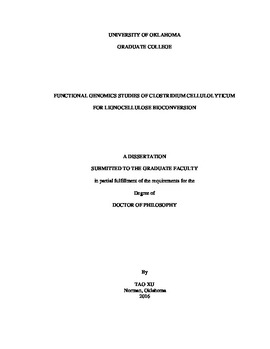| dc.description.abstract | The astonishing consumption of fossil fuels arouses serious concerns over energy security and environmental sustainability. Lignocellulosic biofuel, as a sustainable and carbon-neutral energy that can be produced from lignocellulosic biomass, has the potential to mitigate these pressures. However, the pace of microbial engineering towards efficient and cost-effective biofuel production has been hindered mainly due to the limited knowledge of biological systems in potential microbes and the lack of robust genome engineering tools for efficient functional genomics studies and engineering-oriented practices. Research in the model organism of mesophilic cellulolytic clostridia, Clostridium cellulolyticum, which can perform one-step lignocellulose bioconversion, is still facing the same challenges. The two major objectives of this dissertation are to: 1) develop genome editing tools that allow us to efficiently manipulate both essential and non-essential genes in a targeted manner; 2) conduct comprehensive studies on key metabolic genes, cellulose-degrading cellulosomes, and catabolite regulation systems to increase our understanding of carbohydrate assimilation and metabolism in C. cellulolyticum.
From the aspect of method development, the revolutionary Cas9 nuclease-mediated genome engineering tool was timely and successfully adapted to edit the genome of C. cellulolyticum. The established method employs a mutated Cas9 nickase to generate a single nick at the specific target site to trigger homologous recombination. It overcomes the toxicity of severe DNA damages that previously reported Cas9-based editing methods can cause. With intensive editing tests in C. cellulolyticum, this method presented the advantage of marker-independent gene delivery, versatile editing, and multiplex editing in a single step at a very high editing efficiency and specificity. Besides, our combinatorial method using the Cas9 nickase editing tool to integrate gene repression modules into the chromosome was successfully applied to manipulate essential metabolic genes in this bacterium in a plasmid-independent way.
From the aspect of intellectual knowledge, this work firstly reduced acetate production via antisense RNA-mediated repression of the phosphotransacetylase gene. The effectiveness of both plasmid- and chromosome-based repression was compared; however, switching to chromosome-based expression dramatically decreased gene dosage and formed much less functional gene products, which resulted in a weak repression in chromosomal integrants. The challenge was overcome by integrating a tandem promoter-driven RNA expression module to enhance RNA expression.
Second, three cellulosomal components, Dpi, Cel48F and Cel9E, were identified to be important for cellulose degradation in C. cellulolyticum. Dpi was proven to be a cysteine protease inhibitor. Loss of the Dpi encoding gene dramatically decreased the abundance of major cellulosomal components, Cel48F endocellulase and Cel9E exoglucanase. These two cellulases were verified to be almost indispensable for cellulose degradation via mutagenesis. This study provides the first evidence to show the in vivo importance of cellulosomal protease inhibitors in protecting pivotal cellulosomal components from proteolysis.
Third, all predictable components of carbon catabolite regulation (CCR) in C. cellulolyticum were characterized at the physiological, genetic and transcriptional level. This bacterium lost the sugar-transporting phosphotransferase system in the genome and exhibited a very mild reverse catabolite repression. Mutagenesis of the predicted regulatory system of CCR, including hprK, crh and ccpA, showed that cellobiose assimilation was independent of CCR under our test condition, but the utilization of monomers (both pentoses and hexoses) and insoluble cellulose were tightly associated with CCR. This study also provided the first genetic evidence to show the indispensability of the crh and ccpA genes in cellulose catabolism. Thus, carbohydrate utilization in this bacterium presented differential reliance on this regulation system. Transcriptomic analysis found that the crh gene played a significant regulatory role in gene expression; two other LacI member regulators lfpC2 and lfpC3, which are similar to the ccpA gene, presented functional specificity and redundancy; the ccpA gene exerted minimal impacts when cells grow on soluble sugars.
Aforementioned functional genomics studies provide novel insights into the physiological and genetic importance of a series of genes in sugar assimilation, cellulose degradation and cellular metabolism in C. cellulolyticum. These discoveries will help microbial engineers to develop feasible strategies to improve lignocellulose bioconversion. The developed Cas9 nickase-based genome editing tool and its derivative, Cas9 nickase-assisted RNA repression, will facilitate microbial gene/genome modification for fundamental and applied research. | en_US |

